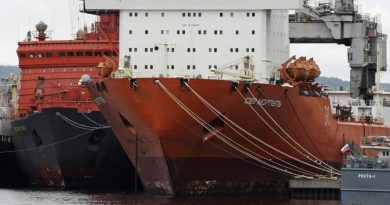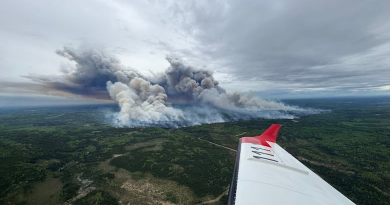New U.S. Arctic strategy focuses on ‘day-to-day competition’ with Russia and China

Rapidly melting sea ice and increasingly navigable Arctic waters – a so-called Blue Arctic – will create new challenges and opportunities for the United States, requiring “sustained American naval presence and partnerships in the Arctic region,” according to the new U.S. Navy and Marine Corps Arctic strategy.
The strategy released on Tuesday by outgoing Navy Secretary Kenneth Braithwaite cites an expected rise in commercial shipping, natural resource exploration and increased military competition with Russia and China in the Arctic, calling on the Navy and the Marine Corps to focus on “day-to-day” competition with Moscow and Beijing “whose interests and values differ dramatically from ours.”
The strategy identifies the area “stretching from Maine in the North Atlantic across the Arctic Ocean through the Bering Strait and Alaska in the North Pacific to the southern tip of the Aleutian Island chain” as an area of vital U.S. interests and calls for “fostering compliance with existing rules to assure a peaceful and prosperous Arctic Region.”
“Competing views of how to control increasingly accessible marine resources and sea routes, unintended military accidents and conflict, and spill-over of major power competition in the Arctic all have the potential to threaten U.S. interests and prosperity,” reads the strategy.
“These challenges are compounded by increasing risk of environmental degradation and disasters, accidents at sea, and displacement of people and wildlife as human activity increases in the region.”
The strategy, dubbed A Blue Arctic: A Strategic Blueprint for the Arctic, comes on the heels of last month’s “Tri-Service” maritime strategy released by the Navy, Marines and Coast Guard and calls for close collaboration with domestic and foreign partners to meet the challenges ahead. The U.S. Air Force released its Arctic strategy, dubbed North Star, in July of 2020.
Focus on Russia and China

Rob Huebert, a Canadian defence expert, said the U.S. Army is also expected to release its Arctic strategy shortly.
“This is the first time we’ve ever seen all four services within the U.S. come up with individual Arctic strategies,” Huebert said.
This points to an increasing awareness of and focus on the Arctic, and the challenges posed by Russia and China among U.S. policy makers, he added.
Previous U.S. Arctic policy documents were much more focused on impacts of climate change and dealing with those challenges in a cooperative environment with all the Arctic nations, including Russia, while China was barely mentioned, Huebert said.
“What has fundamentally changed and this changed, of course, with [Secretary of State Mike] Pompeo’s speech at the Arctic Council where he out and out identifies both the Russians and the Chinese as a growing threat to the United States in the Arctic region,” Huebert said.
“And now the various forces – in this case the Navy and the Marines – have to be prepared. They know that the best way to a peaceful Arctic is through strength.”
Therefore, a lot of the new strategy document talks about renewed interest in capability that the U.S. Navy along with its friends and allies needs to engage in the Arctic, he added.
“First and foremost, they want to be cooperative but they want to be alert to what is happening, they’re going to have to work with friends and allies, they’re going to have to improve the infrastructure that’s in the Arctic to serve both the Marines and the Navy,” Huebert said.
“And they’re going to start thinking about how they can ensure that their actual fleets are able to operate in and near those waters.”
Stepped surface presence in the Arctic
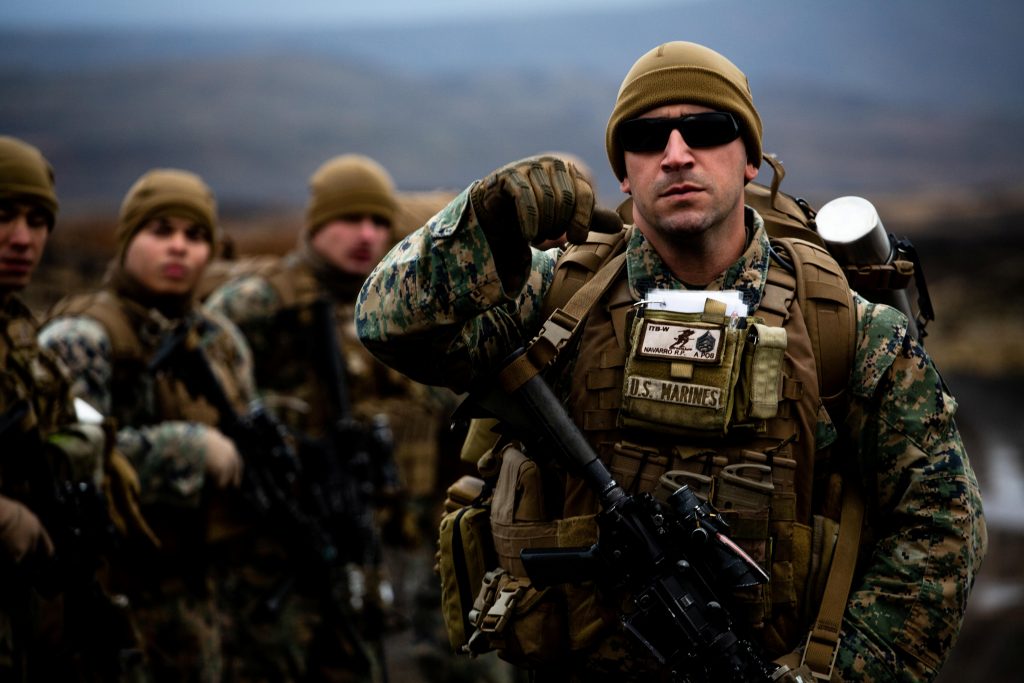
Braithwaite told reporters that while the U.S. military has remained present in the Arctic in recent decades, that presence has largely been projected by the Navy submarines under the ice and the U.S. Air Force in the air.
However, as competition with Russia and China in the region grows, the Navy and Marine Corps have to have a more visible surface presence in the Arctic, operating in all international waters, including those above the Arctic Circle, Braithwaite said.
“You will see the Navy operating again in a more permanent manner above the Arctic Circle,” Braithwaite told reporters.
When asked by a reporter whether the U.S. Navy should conduct Freedom of Navigation Operations (FONOPS) off Russia’s Arctic coastline, Braithwaite said that just like in the case with the U.S. freedom of navigation operations in the South China Sea, Washington reserves the right to “be more present in that part of the world.”
“Again, where sea lanes open up in the northern passage becomes navigable, the U.S. Navy is going to guarantee that freedom of navigation exists for our partners,” Braithwaite told reporters.
Challenging Russia’s ‘excessive maritime claims’
Troy Bouffard, director of the Center for Arctic Security and Resilience at the University of Alaska Fairbanks, said it was time for the U.S. to deal with Russia’s “excessive” maritime claims off its Arctic coast “one way or the other.”
“Either we let them have this, or if we’re not going to, which we’re not, it has to be dealt with,” Bouffard said. “And Russia is not budging on this one.”
The way Russia has drawn its baselines off its Arctic coastline and enshrined the maritime boundary in its national legislation presents a “big problem for the United States,” Bouffard said.
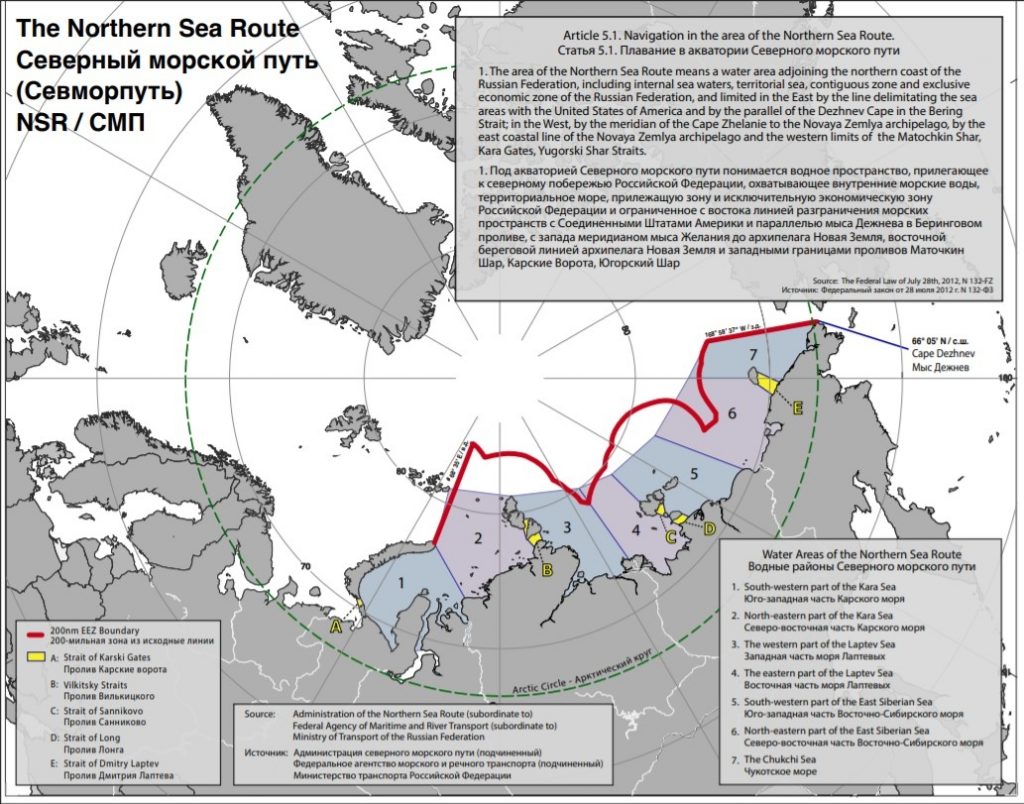
Russia is essentially claiming its entire exclusive economic zone extending 200 nautical miles into the Arctic Ocean as “internal waters,” he said.
“There is no other situation like this on the planet where a state is claiming that much maritime territory as internal waters,” Bouffard said.
Under the UN Convention on the Law of the Sea (UNCLOS), a coastal state owns the surface of internal waters, the water column, the seabed and below, he added.
“That is the problem for the United States, claiming that amount of water as internal waters, as complete and total control by Russia is extremely far beyond the international norm,” Bouffard said.
“Thus that means that this whole Northern Sea Route by definition is contested waters for the United States.”
The reason that Russia can even make a claim to these waters is because of the Article 234 of the UNCLOS treaty, which deals with ice-covered areas of the planet, he said.
Under that article, “Coastal States have the right to adopt and enforce non-discriminatory laws and regulations for the prevention, reduction and control of marine pollution from vessels in ice-covered areas within the limits of the exclusive economic zone…”
“Russia is totally abusing the interpretation of that article,” Bouffard said.
Russia has also been trying to set up a very legitimate international case to defend its claims in the Arctic, he said.
“If they have to go to court over this, they’ve been preparing a really strong case to do so,” Bouffard said.
‘That’s why we do FONOPs’
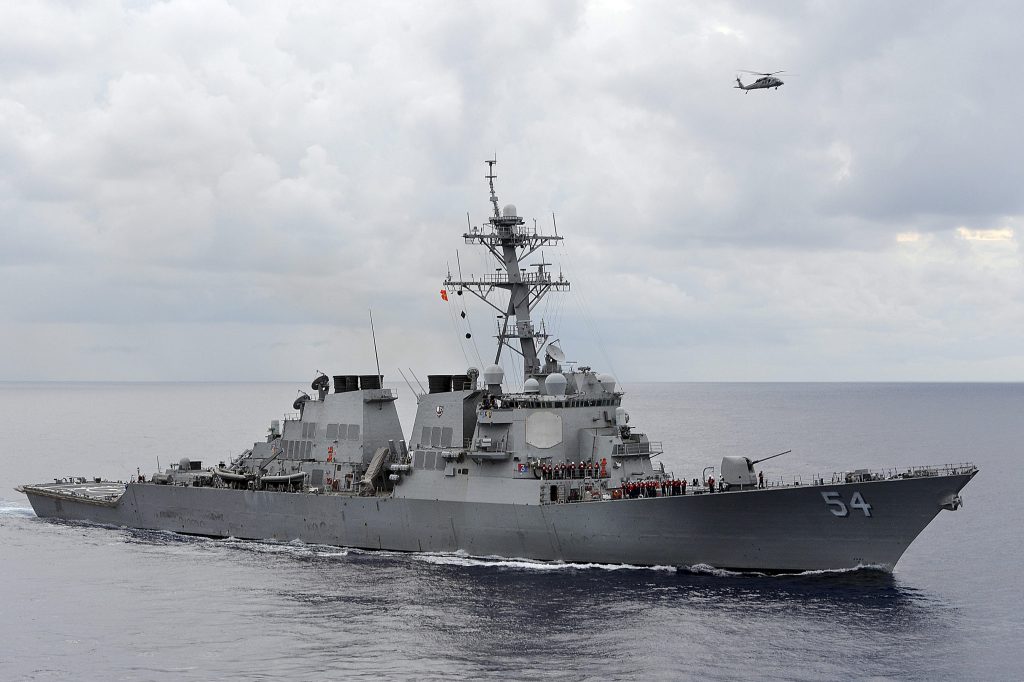
One of the ways in international law that states can keep an issue open and not resolved is to keep challenging another state’s claims, he said.
“Most of the time you just send an official diplomatic communication that says, ‘We still don’t recognize your claim,'” Bouffard said.
“But another way to do that – and to do it emphatically in the maritime world – is to shove a vessel there to basically underline, ‘We really do not recognize your claim.’ That’s why we do FONOPs.”
Bouffard said conducting a FONOP in the aquatory of the Northern Sea Route would cause a huge backlash in Russia and it would require close cooperation between the Department of Defense and the State Department.
“If we go within the EEZ, if we go into the internal waters of the Northern Sea Route, they are going to take that extremely seriously, that won’t be blustery back and forth, that will be an international incident,” Bouffard said.
“They really want this forever and ever to be internal waters. If they can make this stick, they will never have to worry about vessels and other things that are coming near their coast. They will never have to deal with any of that if they can set up this huge buffer zone.”
Conducting a FONOP in the Northern Sea Route would also be extremely challenging for the U.S. Navy, which not only doesn’t have ice strengthened surface vessels but also lacks charts to navigate the extremely shallow and dangerous continental shelf off Russia’s Arctic coast, Bouffard said.
“That is bathymetric data and navigational data that Russia would not share with anybody,” Bouffard said. “So in essence it keeps a lot of control just by the fact that it is actually very risky to navigate in those waters. It would be a huge embarrassment if we got into trouble.”
But the U.S. vessels don’t have to go into those shallow areas, they can go to areas where they have reliable enough bathymetric data, he added.
“You only have to go in a little bit and then pop out,” Bouffard said. “We don’t have to traverse the entire Northern Sea Route or through the risky areas that are not charted well. Just got to pop in and pop out and you’ve conducted a FONOP.”
It could even be done using submarines, he added.
“If they’re trying to track all of our surface vessels, which is really hard to do in the Arctic, you can do it with subs,” Bouffard said. “The United States and other nations have a pretty decent capability of conducting a FONOP with little risk from actual contact.”
Russian officials have yet to react to the release of the U.S. Navy’s Arctic strategy and Braithwaite’s comments.
Related stories from around the North:
Arctic: NATO’s Arctic dilemma: Two visions of the Arctic collide as NATO and Russia flex muscles, Eye on the Arctic
Canada: Experts warn of potentially ‘deadly’ great power games in the Arctic, Radio Canada International
China: China, Russia singled out in new U.S. Arctic defense strategy, Eye on the Arctic
Denmark: Pompeo to talk Arctic at upcoming meeting with Danish Foreign Minister, Eye on the Arctic
Iceland: Nordics should aim for common approach to China’s Arctic involvement says report, Eye on the Arctic
Norway: Increase in NATO scrambled jets from Norway, The Independent Barents Observer
Russia: Russian navy conducts major manoeuvres near Alaska, The Associated Press
Sweden: Sweden’s FM calls for more EU involvement in Arctic as country hosts EU Arctic Forum, Radio Sweden
United States: NATO’s new Atlantic command to keep watch over the European Arctic, Eye on the Arctic

